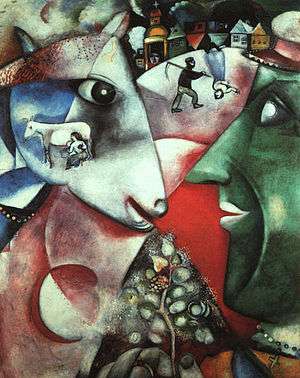20th century
| Millennium: | 2nd millennium |
|---|---|
| Centuries: | |
| Timelines: | |
| State leaders: | |
| Decades: | |
| Categories: | Births – Deaths Establishments – Disestablishments |

The 20th century was a century that began on January 1, 1901[1] and ended on December 31, 2000.[2] It was the tenth and final century of the 2nd millennium. It is distinct from the century known as the 1900s which began on January 1, 1900 and ended on December 31, 1999.
The 20th century was dominated by a chain of events that heralded significant changes in world history as to redefine the era: flu pandemic, World War I and World War II, nuclear power and space exploration, nationalism and decolonization, the Cold War and post-Cold War conflicts; intergovernmental organizations and cultural homogenization through developments in emerging transportation and communications technology; poverty reduction and world population growth, awareness of environmental degradation, ecological extinction;[3][4] and the birth of the Digital Revolution. It saw great advances in communication and medical technology that by the late 1980s allowed for near-instantaneous worldwide computer communication and genetic modification of life.
Global total fertility rates, sea level rise and ecological collapses increased; the resulting competition for land and dwindling resources accelerated deforestation, water depletion, and the mass extinction of many of the world's species and decline in the population of others; consequences which are now being dealt with. It took over two-hundred thousand years of human history up to 1804 for the world's population to reach 1 billion;[5] world population reached an estimated 2 billion in 1927; by late 1999, the global population reached 6 billion.[6] Global literacy averaged 80%; global lifespan-averages exceeded 40+ years for the first time in history, with over half achieving 70+ years (three decades longer than it was a century ago).[7]
Overview
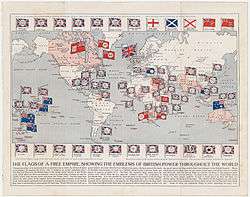
The century had the first global-scale total wars between world powers across continents and oceans in World War I and World War II. Nationalism became a major political issue in the world in the 20th century, acknowledged in international law along with the right of nations to self-determination, official decolonization in the mid-century, and related regional conflicts.
The century saw a major shift in the way that many people lived, with changes in politics, ideology, economics, society, culture, science, technology, and medicine. The 20th century may have seen more technological and scientific progress than all the other centuries combined since the dawn of civilization. Terms like ideology, world war, genocide, and nuclear war entered common usage. Scientific discoveries, such as the theory of relativity and quantum physics, profoundly changed the foundational models of physical science, forcing scientists to realize that the universe was more complex than previously believed, and dashing the hopes (or fears) at the end of the 19th century that the last few details of scientific knowledge were about to be filled in. It was a century that started with horses, simple automobiles, and freighters but ended with high-speed rail, cruise ships, global commercial air travel and the Space Shuttle. Horses, Western society's basic form of personal transportation for thousands of years, were replaced by automobiles and buses within a few decades. These developments were made possible by the exploitation of fossil fuel resources, which offered energy in an easily portable form, but also caused concern about pollution and long-term impact on the environment. Humans explored space for the first time, taking their first footsteps on the Moon.
Mass media, telecommunications, and information technology (especially computers, paperback books, public education, and the Internet) made the world's knowledge more widely available. Advancements in medical technology also improved the health of many people: the global life expectancy increased from 35 years to 65 years. Rapid technological advancements, however, also allowed warfare to reach unprecedented levels of destruction. World War II alone killed over 60 million people, while nuclear weapons gave humankind the means to annihilate itself in a short time. However, these same wars resulted in the destruction of the imperial system. For the first time in human history, empires and their wars of expansion and colonization ceased to be a factor in international affairs, resulting in a far more globalized and cooperative world. The last time major powers clashed openly was in 1945, and since then, violence has seen an unprecedented decline.[8]
The world also became more culturally homogenized than ever with developments in transportation and communications technology, popular music and other influences of Western culture, international corporations, and what was arguably a true global economy by the end of the 20th century.
Summary
Technological advancements during World War I changed the way war was fought, as new inventions such as tanks, chemical weapons, and aircraft modified tactics and strategy. After more than four years of trench warfare in western Europe, and 20 million dead, the powers that had formed the Triple Entente (France, Britain, and Russia, later replaced by the United States and joined by Italy and Romania) emerged victorious over the Central Powers (Germany, Austria-Hungary, the Ottoman Empire and Bulgaria). In addition to annexing much of the colonial possessions of the vanquished states, the Triple Entente exacted punitive restitution payments from them, plunging Germany in particular into economic depression. The regime of Tsar Nicholas II was overthrown during the conflict, Russia became the first communist state, and the Austro-Hungarian and Ottoman empires were dismantled at the war's conclusion.

At the beginning of the period, Britain was the world's most powerful nation,[10] having acted as the world's policeman for the past century. Fascism, a movement which grew out of post-war angst and which accelerated during the Great Depression of the 1930s, gained momentum in Italy, Germany and Spain in the 1920s and 1930s, culminating in World War II, sparked by Nazi Germany's aggressive expansion at the expense of its neighbors. Meanwhile, Japan had rapidly transformed itself into a technologically advanced industrial power. Its military expansion into eastern Asia and the Pacific Ocean culminated in a surprise attack on the United States, bringing it into World War II. After some years of dramatic military success, Germany was defeated in 1945, having been invaded by the Soviet Union and Poland from the east and by the United States, the United Kingdom, Canada, and Free France from the west. The war ended with the dropping of two atomic bombs on Japan. Japan later became a western ally with an economy based on the manufacture of consumer goods and trade. Germany was divided between the Western powers (West Germany) and the Soviet Union; all areas recaptured by the Soviet Union (East Germany and eastward) became Soviet puppet states under communist rule. Meanwhile, Western European countries were influenced by the American Marshall Plan and made a quick economic recovery, becoming major allies of the United States under capitalist economies and relatively democratic governments.
World War II left about 60 million people dead. When the conflict ended in 1945, the United States and the Soviet Union emerged as the major world powers. Allies during the war, they soon became hostile to one another as the competing ideologies of communism and democratic capitalism occupied Europe, divided by the Iron Curtain and the Berlin Wall. The military alliances headed by these nations (NATO in North America and Western Europe; the Warsaw Pact in Eastern Europe) threatened each other with total war in what was called the Cold War (1947–91). The period was marked by a new arms race, and nuclear weapons were produced in the tens of thousands, sufficient to end most human life on the planet had a large-scale nuclear exchange ever occurred. The size of the nuclear arsenals is believed by many historians to have staved off war between the two, as the consequences were too great to bear. The policy of massive nuclear attack, knowing a similar counterattack would be forthcoming, was called mutually assured destruction (MAD). However, several proxy wars, such as the Korean War (1950–1953) and the Vietnam War (1955–1975), were waged as the United States implemented its worldwide "containment" policy against communism.

After World War II, most of the European-colonized world in Africa and Asia gained independence in a process of decolonization. Meanwhile, the wars empowered several nations, including the UK, USA, Russia, China and Japan, to exert a strong influence over many world affairs. American culture spread around the world with the advent of the Hollywood motion picture industry, Broadway, rock and roll, pop music, fast food, big-box stores, and the hip-hop lifestyle. Britain continued to influence world culture, including the British Invasion—The Rolling Stones, The Beatles—into American music, leading many rock bands from other countries (such as Swedish ABBA) to sing in English. The western world and parts of Asia enjoyed a post–World War II economic expansion. After the Soviet Union collapsed under internal pressure in 1991, the communist governments of the Eastern bloc were dismantled, followed by awkward transitions into market economies.
Following World War II, the United Nations, successor to the League of Nations, was established as an international forum in which the world's nations could discuss issues diplomatically. It enacted resolutions on such topics as the conduct of warfare, environmental protection, international sovereignty, and human rights. Peacekeeping forces consisting of troops provided by various countries, with various United Nations and other aid agencies, helped to relieve famine, disease, and poverty, and to suppress some local armed conflicts. Europe slowly united, economically and, in some ways, politically, to form the European Union, which consisted of 15 European countries by the end of the 20th century.
In the last third of the century, concern about humankind's impact on the Earth's environment made environmentalism popular. In many countries, especially in Europe, the movement was channeled into politics through Green parties. Increasing awareness of global warming began in the 1980s, commencing decades of social and political debate.

The nature of innovation and change
Due to continuing industrialization and expanding trade, many significant changes of the century were, directly or indirectly, economic and technological in nature. Inventions such as the light bulb, the automobile, and the telephone in the late 19th century, followed by supertankers, airliners, motorways, radio, television, antibiotics, frozen food, computers and microcomputers, the Internet, and mobile telephones affected people's quality of life across the developed world. Scientific research, engineering professionalization and technological development drove changes in everyday life.
Social change
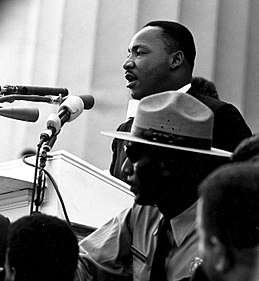
At the beginning of the century, strong discrimination based on race and sex was significant in general society. Although the Atlantic slave trade had ended in the 19th century, the fight for equality for non-white people in white-dominated societies of North America, Europe, and South Africa continued. During the century, the social taboo of sexism fell. By the end of the 20th century, women had the same legal rights as men in many parts of the world, and racism had come to be seen as abhorrent.[11] Attitudes towards homosexuality also began to change in the later part of the century.
The world at the end of the 20th century
Communications and information technology, transportation technology, and medical advances had radically altered daily lives. Europe appeared to be at a sustainable peace for the first time in recorded history. The people of the Indian subcontinent, a sixth of the world population at the end of the 20th century, had attained an indigenous independence for the first time in centuries. China, an ancient nation comprising a fifth of the world population, was finally open to the world in a new and powerful synthesis of west and east, creating a new state after the near-complete destruction of the old cultural order. With the end of colonialism and the Cold War, nearly a billion people in Africa were left in new nation states after centuries of foreign domination.
The world was undergoing its second major period of globalization; the first, which started in the 18th century, having been terminated by World War I. Since the US was in a dominant position, a major part of the process was Americanization. The influence of China and India was also rising, as the world's largest populations were rapidly integrating with the world economy.
Terrorism, dictatorship, and the spread of nuclear weapons were some issues requiring attention. The world was still blighted by small-scale wars and other violent conflicts, fueled by competition over resources and by ethnic conflicts. Despots such as Kim Jong-il of North Korea continued to lead their nations toward the development of nuclear weapons.
Disease threatened to destabilize many regions of the world. New viruses such as SARS and West Nile continued to spread. Malaria and other diseases affected large populations. Millions were infected with HIV, the virus which causes AIDS. The virus was becoming an epidemic in southern Africa.
Based on research done by climate scientists, the majority of the scientific community consider that in the long term environmental problems may threaten the planet's habitability.[12] One argument is that of global warming occurring due to human-caused emission of greenhouse gases, particularly carbon dioxide produced by the burning of fossil fuels.[13] This prompted many nations to negotiate and sign the Kyoto treaty, which set mandatory limits on carbon dioxide emissions.
World population increased from about 1.6 billion people in 1901 to 6.1 billion at the century's end.[14][15]
Wars and politics
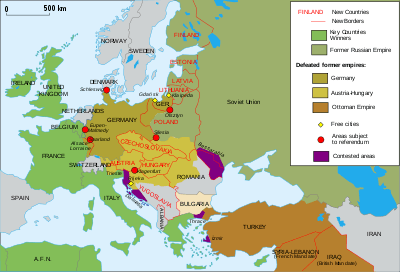
The number of people killed during the century by government actions was in the hundreds of millions. This includes deaths caused by wars, genocide, politicide and mass murders. The deaths from acts of war during the two world wars alone have been estimated at between 50 and 80 million. Political scientist Rudolph Rummel estimated 262,000,000 deaths caused by democide, which excludes those killed in war battles, civilians unintentionally killed in war and killings of rioting mobs.[16] According to Charles Tilly, "Altogether, about 100 million people died as a direct result of action by organized military units backed by one government or another over the course of the century. Most likely a comparable number of civilians died of war-induced disease and other indirect effects."[17] It is estimated that approximately 70 million Europeans died through war, violence and famine between 1914 and 1945.[18]
- After gaining political rights in the United States and much of Europe in the first part of the century, and with the advent of new birth control techniques, women became more independent throughout the century.
- Rising nationalism and increasing national awareness were among the many causes of World War I (1914–1918), the first of two wars to involve many major world powers including Germany, France, Italy, Japan, Russia/USSR, the British Empire and the United States. World War I led to the creation of many new countries, especially in Eastern Europe. At the time, it was said by many to be the "war to end all wars".
- Industrial warfare greatly increased in its scale and complexity during the first half of the 20th century. Notable developments included chemical warfare, the introduction of military aviation and the widespread use of submarines. The introduction of nuclear warfare in the mid-20th century marked the definite transition to modern warfare.
- Civil wars occurred in many nations. A violent civil war broke out in Spain in 1936 when General Francisco Franco rebelled against the Second Spanish Republic. Many consider this war as a testing battleground for World War II, as the fascist armies bombed some Spanish territories.
- The Great Depression in the 1930s led to the rise of Fascism and Nazism in Europe.
- World War II (1939–1945) involved Eastern Asia and the Pacific, in the form of Japanese aggression against China and the United States. Civilians also suffered greatly in World War II, due to the aerial bombing of cities on both sides, and the German genocide of the Jews and others, known as the Holocaust.
- During World War I, in the Russian Revolution of 1917, 300 years of Romanov reign were ended and the Bolsheviks, under the leadership of Vladimir Lenin, established the world's first Communist state. After the Soviet Union's involvement in World War II, communism became a major force in global politics, notably in Eastern Europe, China, Indochina and Cuba, where communist parties gained near-absolute power. This led to the Cold War and proxy wars with the Western bloc, including wars in Korea (1950–1953) and Vietnam (1957–1975).
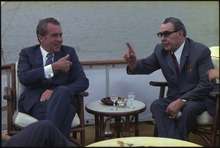
- The Cold War had caused an arms race and increasing competition between the two major players in the world: the Soviet Union and the United States. This competition included the development and improvement of nuclear weapons and the Space Race.
- The Soviet authorities caused the deaths of millions of their own citizens in order to eliminate domestic opposition.[19] More than 18 million people passed through the Gulag, with a further 6 million being exiled to remote areas of the Soviet Union.[20]
- The civil rights movement in the United States and the movement against apartheid in South Africa challenged racial segregation in those countries.
- The two world wars led to efforts to increase international cooperation, notably through the founding of the League of Nations after World War I, and its successor, the United Nations, after World War II.
- Nationalist movements in the subcontinent led to the independence and partition of India and Pakistan.
- Gandhi's nonviolence and Indian independence movement against the British Empire influenced many political movements around the world, including the civil rights movement in the U.S., and freedom movements in South Africa and Burma.
- The creation in 1948 of Israel, a Jewish state in the Middle East, by the British Mandate of Palestine fueled many regional conflicts. These were also influenced by the vast oil fields in many of the other countries of the mostly Arab region.
- The end of colonialism led to the independence of many African and Asian countries. During the Cold War, many of these aligned with the United States, the USSR, or China for defense.
- After a long period of civil wars and conflicts with western powers, China's last imperial dynasty ended in 1912. The resulting republic was replaced, after another civil war, by a communist People's Republic in 1949. At the end of the 20th century, though still ruled by a communist party, China's economic system had largely transformed to capitalism.
- The Great Chinese Famine was a direct cause of the death of tens of millions of Chinese peasants between 1959 and 1962. It is thought to be the largest famine in human history.[21]
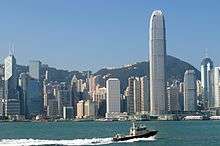
- The Vietnam War caused two million deaths, changed the dynamics between the Eastern and Western Blocs, and altered North-South relations.[22]
- The Soviet War in Afghanistan caused one million deaths and contributed to the downfall of the Soviet Union.[21]
- The revolutions of 1989 released Eastern and Central Europe from Soviet supremacy. Soon thereafter, the Soviet Union, Czechoslovakia, and Yugoslavia dissolved, the latter violently over several years, into successor states, many rife with ethnic nationalism. Meanwhile, East Germany and West Germany were reunified in 1990.
- The Tiananmen Square protests of 1989, culminating in the deaths of hundreds of civilian protesters, were a series of demonstrations in and near Tiananmen Square in Beijing, China. Led mainly by students and intellectuals, the protests occurred in a year that saw the collapse of a number of communist governments around the world.
- European integration began in earnest in the 1950s, and eventually led to the European Union, a political and economic union that comprised 15 countries at the end of the 20th century.
Culture and entertainment
- As the century began, Paris was the artistic capital of the world, where both French and foreign writers, composers and visual artists gathered. By the end of the century New York City had become the artistic capital of the world.
- Theater, films, music and the media had a major influence on fashion and trends in all aspects of life. As many films and much music originate from the United States, American culture spread rapidly over the world.
- 1953 saw the coronation of Queen Elizabeth II, an iconic figure of the century.
- Visual culture became more dominant not only in films but in comics and television as well. During the century a new skilled understanding of narrativist imagery was developed.
- Computer games and internet surfing became new and popular form of entertainment during the last 25 years of the century.
- In Literature, science fiction, fantasy (with well-developed fictional worlds, rich in detail), and alternative history fiction gained unprecedented popularity. Detective fiction gained unprecedented popularity in the interwar period. In the United States in 1961 Grove Press published Tropic of Cancer a novel by Henry Miller redefining pornography and censorship in publishing in America.
Music
The invention of music recording technologies such as the phonograph record, and dissemination technologies such as radio broadcasting, massively expanded the audience for music. Prior to the 20th century, music was generally only experienced in live performances. Many new genres of music were established during the 20th century.

- Igor Stravinsky revolutionized classical composition.
- In classical music, composition branched out into many completely new domains, including dodecaphony, aleatoric (chance) music, and minimalism.
- Tango was created in Argentina and became extremely popular in the rest of the Americas and Europe.
- Blues and jazz music became popularized during the 1910s and 1920s in the United States.
- Blues went on to influence rock and roll in the 1950s, which along with Folk Music, increased in popularity with the British Invasion of the mid-to-late 1960s.
- Rock soon branched into many different genres, including Folk rock, heavy metal, punk rock, and alternative rock and became the dominant genre of popular music.
- This was challenged with the rise of hip hop in the 1980s and 1990s.
- Other genres such as house, techno, reggae, and soul all developed during the latter half of the century and went through various periods of popularity.
- Synthesizers began to be employed widely in music and crossed over into the mainstream with new wave music in the 1980s. Electronic instruments have been widely deployed in all manners of popular music and has led to the development of such genres as house, synthpop, electronic dance music, and industrial.
The world's most popular / famous music artists of the 20th century include : Louis Armstrong, Duke Ellington, Bing Crosby, ABBA, The Beach Boys, The Beatles, Harry Belafonte, Little Richard, Chuck Berry, James Brown, Miles Davis, Bob Dylan, Jimi Hendrix, Michael Jackson, Elton John, Robert Johnson, Led Zeppelin, Queen, Madonna, Bob Marley, Charlie Parker, Pink Floyd, Elvis Presley, The Rolling Stones, Frank Sinatra, Stevie Wonder, Tupac Shakur, Nirvana (band), The Notorious B.I.G.,Amr Diab , Fairuz, Umm Kulthum,Abdel Halim Hafez and many more.
Film, television and theatre
Film as an artistic medium was created in the 20th century. The first modern movie theatre was established in Pittsburgh in 1905.[23] Hollywood developed as the center of American film production. While the first films were in black and white, technicolor was developed in the 1920s to allow for color films. Sound films were developed, with the first full-length feature film, The Jazz Singer, released in 1927. The Academy Awards were established in 1929.
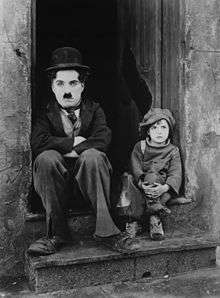
- Humphrey Bogart, James Stewart, Sidney Poitier, Marlon Brando, Charlie Chaplin, Bruce Lee, James Dean, Clark Gable, Cary Grant, Audrey Hepburn, Katharine Hepburn, Marilyn Monroe, Harry Belafonte,Paul Newman, Lena Horne, Elizabeth Taylor, Julie Andrews, and John Wayne, are among the most popular film stars of the 20th century.
- D. W. Griffith, Sergei Eisenstein, Cecil B. DeMille, Frank Capra, Oscar Micheaux, Howard Hawks, John Ford, Orson Welles, John Huston, Alfred Hitchcock, Akira Kurosawa, Ingmar Bergman, Federico Fellini, Walt Disney, Stanley Kubrick, Steven Spielberg, Quentin Tarantino, James Cameron, Spike Lee, and George Lucas are among the most important and popular filmmakers of the 20th century.
- In theater, sometimes referred to as Broadway in New York City, playwrights like Eugene O'Neill, Samuel Beckett, Edward Albee, Arthur Miller and Tennessee Williams introduced innovative language and ideas to the idiom. In musical theater, figures like Rodgers and Hammerstein, Lerner and Loewe, and Irving Berlin had an enormous impact on both film and the culture in general.
.jpg) The Empire State Building is an iconic building of the 1930s.
The Empire State Building is an iconic building of the 1930s. - Modern Dance is born in America as both a 'rebellion' against centuries-old European ballet, as well as born from the oppression in America. Dancers and choreographers Alvin Ailey, Isadora Duncan, Vaslav Nijinsky, Ruth St. Denis, Martha Graham, Jose Limon, Doris Humphrey, Merce Cunningham, and Paul Taylor re-defined movement, struggling to bring it back to its 'natural' roots and along with Jazz, created a solely American art form. Alvin Ailey is credited with popularizing modern dance and revolutionizing African-American participation in 20th-century concert dance. His company gained the nickname "Cultural Ambassador to the World" because of its extensive international touring. Ailey's choreographic masterpiece Revelations is believed to be the best known and most often seen modern dance performance.
Art and Architecture
- The art world experienced the development of new styles and explorations such as fauvism, expressionism, Dadaism, cubism, de stijl, surrealism, abstract expressionism, color field, pop art, minimal art, lyrical abstraction, and conceptual art.
- The modern art movement revolutionized art and culture and set the stage for both Modernism and its counterpart postmodern art as well as other contemporary art practices.
- Art Nouveau began as advanced architecture and design but fell out of fashion after World War I. The style was dynamic and inventive but unsuited to the depression of the Great War.
- In Europe, modern architecture departed from the decorated styles of the Victorian era. Streamlined forms inspired by machines became commonplace, enabled by developments in building materials and technologies. Before World War II, many European architects moved to the United States, where modern architecture continued to develop.
- The automobile increased the mobility of people in the Western countries in the early-to-mid-century, and in many other places by the end of the 20th century. City design throughout most of the West became focused on transport via car.
Sport
- The popularity of sport increased considerably—both as an activity for all, and as entertainment, particularly on television.
- The modern Olympic Games, first held in 1896, grew to include tens of thousands of athletes in dozens of sports.
- The FIFA World Cup was first held in 1930, and was held every 4 years after World War II.
Science
Mathematics

Multiple new fields of mathematics were developed in the 20th century. In the first part of the 20th century, measure theory, functional analysis, and topology were established, and significant developments were made in fields such as abstract algebra and probability. The development of set theory and formal logic led to Gödel's incompleteness theorems.
Later in the 20th century, the development of computers led to the establishment of a theory of computation.[24] Other computationally-intense results include the study of fractals[25] and a proof of the four color theorem in 1976.[26]
Physics
- New areas of physics, like special relativity, general relativity, and quantum mechanics, were developed during the first half of the century. In the process, the internal structure of atoms came to be clearly understood, followed by the discovery of elementary particles.
- It was found that all the known forces can be traced to only four fundamental interactions. It was discovered further that two forces, electromagnetism and weak interaction, can be merged in the electroweak interaction, leaving only three different fundamental interactions.
- Discovery of nuclear reactions, in particular nuclear fusion, finally revealed the source of solar energy.
- Radiocarbon dating was invented, and became a powerful technique for determining the age of prehistoric animals and plants as well as historical objects.
Astronomy
- A much better understanding of the evolution of the universe was achieved, its age (about 13.8 billion years) was determined, and the Big Bang theory on its origin was proposed and generally accepted.
- The age of the solar system, including Earth, was determined, and it turned out to be much older than believed earlier: more than 4 billion years, rather than the 20 million years suggested by Lord Kelvin in 1862.[27]
- The planets of the solar system and their moons were closely observed via numerous space probes. Pluto was discovered in 1930 on the edge of the solar system, although in the early 21st century, it was reclassified as a plutoid instead of a planet proper, leaving eight planets.
- No trace of life was discovered on any of the other planets in our solar system (or elsewhere in the universe), although it remained undetermined whether some forms of primitive life might exist, or might have existed, somewhere. Extrasolar planets were observed for the first time.
Biology
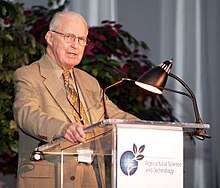
- Genetics was unanimously accepted and significantly developed. The structure of DNA was determined in 1953 by James Watson,[28][29] Francis Crick,[28][29] Rosalind Franklin[29] and Maurice Wilkins,[28][29] following by developing techniques which allow to read DNA sequences and culminating in starting the Human Genome Project (not finished in the 20th century) and cloning the first mammal in 1996.
- The role of sexual reproduction in evolution was understood, and bacterial conjugation was discovered.
- The convergence of various sciences for the formulation of the modern evolutionary synthesis (produced between 1936 and 1947), providing a widely accepted account of evolution.
Medicine
.jpg)
- Placebo-controlled, randomized, blinded clinical trials became a powerful tool for testing new medicines.
- Antibiotics drastically reduced mortality from bacterial diseases and their prevalence.
- A vaccine was developed for polio, ending a worldwide epidemic. Effective vaccines were also developed for a number of other serious infectious diseases, including influenza, diphtheria, pertussis (whooping cough), tetanus, measles, mumps, rubella (German measles), chickenpox, hepatitis A, and hepatitis B.
- Epidemiology and vaccination led to the eradication of the smallpox virus in humans.
- X-rays became powerful diagnostic tool for wide spectrum of diseases, from bone fractures to cancer. In the 1960s, computerized tomography was invented. Other important diagnostic tools developed were sonography and magnetic resonance imaging.
- Development of vitamins virtually eliminated scurvy and other vitamin-deficiency diseases from industrialized societies.
- New psychiatric drugs were developed. These include antipsychotics for treating hallucinations and delusions, and antidepressants for treating depression.
- The role of tobacco smoking in the causation of cancer and other diseases was proven during the 1950s (see British Doctors Study).
- New methods for cancer treatment, including chemotherapy, radiation therapy, and immunotherapy, were developed. As a result, cancer could often be cured or placed in remission.
- The development of blood typing and blood banking made blood transfusion safe and widely available.
- The invention and development of immunosuppressive drugs and tissue typing made organ and tissue transplantation a clinical reality.
- New methods for heart surgery were developed, including pacemakers and artificial hearts.
- Cocaine/crack and heroin were found to be dangerous addictive drugs, and their wide usage had been outlawed; mind-altering drugs such as LSD and MDMA were discovered and later outlawed. In many countries, a war on drugs caused prices to soar 10–20 times higher, leading to profitable black market drugdealing, and to prison inmate sentences being 80% related to drug use by the 1990s.
- Contraceptive drugs were developed, which reduced population growth rates in industrialized countries, as well as decreased the taboo of premarital sex throughout many western countries.
- The development of medical insulin during the 1920s helped raise the life expectancy of diabetics to three times of what it had been earlier.
- Vaccines, hygiene and clean water improved health and decreased mortality rates, especially among infants and the young.
Notable diseases
- An influenza pandemic, Spanish Flu, killed anywhere from 20 to 100 million people between 1918 and 1919.
- A new viral disease, called the Human Immunodeficiency Virus, or HIV, arose in Africa and subsequently killed millions of people throughout the world. HIV leads to a syndrome called Acquired Immunodeficiency Syndrome, or AIDS. Treatments for HIV remained inaccessible to many people living with AIDS and HIV in developing countries, and a cure has yet to be discovered.
- Because of increased life spans, the prevalence of cancer, Alzheimer's disease, Parkinson's disease, and other diseases of old age increased slightly.
- Sedentary lifestyles, due to labor-saving devices and technology, along with the increase in home entertainment and technology such as television, video games, and the internet contributed to an "epidemic" of obesity, at first in the rich countries, but by the end of the 20th century spreading to the developing world.
Energy and the environment
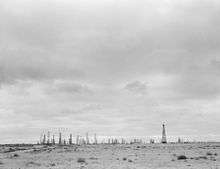
- The dominant use of fossil sources and nuclear power, considered the conventional energy sources.
- Widespread use of petroleum in industry—both as a chemical precursor to plastics and as a fuel for the automobile and airplane—led to the geopolitical importance of petroleum resources. The Middle East, home to many of the world's oil deposits, became a center of geopolitical and military tension throughout the latter half of the century. (For example, oil was a factor in Japan's decision to go to war against the United States in 1941, and the oil cartel, OPEC, used an oil embargo of sorts in the wake of the Yom Kippur War in the 1970s).
- The increase in fossil fuel consumption also fueled a major scientific controversy over its effect on air pollution, global warming, and global climate change.
- Pesticides, herbicides and other toxic chemicals accumulated in the environment, including in the bodies of humans and other animals.
- Overpopulation and worldwide deforestation diminished the quality of the environment.
Engineering and technology

One of the prominent traits of the 20th century was the dramatic growth of technology. Organized research and practice of science led to advancement in the fields of communication, engineering, travel, medicine, and war.
- The number and types of home appliances increased dramatically due to advancements in technology, electricity availability, and increases in wealth and leisure time. Such basic appliances as washing machines, clothes dryers, furnaces, exercise machines, refrigerators, freezers, electric stoves, and vacuum cleaners all became popular from the 1920s through the 1950s. The microwave oven became popular during the 1980s and have become a standard in all homes by the 1990s. Radios were popularized as a form of entertainment during the 1920s, which extended to television during the 1950s. Cable and satellite television spread rapidly during the 1980s and 1990s. Personal computers began to enter the home during the 1970s–1980s as well. The age of the portable music player grew during the 1960s with the development of the transistor radio, 8-track and cassette tapes, which slowly began to replace record players. These were in turn replaced by the CD during the late 1980s and 1990s. The proliferation of the Internet in the mid-to-late 1990s made digital distribution of music (mp3s) possible. VCRs were popularized in the 1970s, but by the end of the 20th century, DVD players were beginning to replace them, making the VHS obsolete by the end of the first decade of the 21st century.
- The first airplane was flown in 1903. With the engineering of the faster jet engine in the 1940s, mass air travel became commercially viable.
- The assembly line made mass production of the automobile viable. By the end of the 20th century, billions of people had automobiles for personal transportation. The combination of the automobile, motor boats and air travel allowed for unprecedented personal mobility. In western nations, motor vehicle accidents became the greatest cause of death for young people. However, expansion of divided highways reduced the death rate.
- The triode tube, transistor and integrated circuit successively revolutionized electronics and computers, leading to the proliferation of the personal computer in the 1980s and cell phones and the public-use Internet in the 1990s.
- New materials, most notably stainless steel, Velcro, silicone, teflon, and plastics such as polystyrene, PVC, polyethylene, and nylon came into widespread use for many various applications. These materials typically have tremendous performance gains in strength, temperature, chemical resistance, or mechanical properties over those known prior to the 20th century.
- Aluminum became an inexpensive metal and became second only to iron in use.
- Semiconductor materials were discovered, and methods of production and purification developed for use in electronic devices. Silicon became one of the purest substances ever produced.
- Thousands of chemicals were developed for industrial processing and home use.
Space exploration

- The Space Race between the United States and the Soviet Union gave a peaceful outlet to the political and military tensions of the Cold War, leading to the first human spaceflight with the Soviet Union's Vostok 1 mission in 1961, and man's first landing on another world—the Moon—with America's Apollo 11 mission in 1969. Later, the first space station was launched by the Soviet space program. The United States developed the first reusable spacecraft system with the Space Shuttle program, first launched in 1981. As the century ended, a permanent manned presence in space was being founded with the ongoing construction of the International Space Station.
- In addition to human spaceflight, unmanned space probes became a practical and relatively inexpensive form of exploration. The first orbiting space probe, Sputnik 1, was launched by the Soviet Union in 1957. Over time, a massive system of artificial satellites was placed into orbit around Earth. These satellites greatly advanced navigation, communications, military intelligence, geology, climate, and numerous other fields. Also, by the end of the 20th century, unmanned probes had visited the Moon, Mercury, Venus, Mars, Jupiter, Saturn, Uranus, Neptune, and various asteroids and comets. The Hubble Space Telescope, launched in 1990, greatly expanded our understanding of the Universe and brought brilliant images to TV and computer screens around the world.
- The Global Positioning System, a series of satellites that allow land-based receivers to determine their exact location, was developed and deployed.[30]
Religion
- The Vatican II council was held from 1962 to 1965, and resulted in significant changes in the Catholic Church.
- The Wahhabi sect of Sunni Islam gained in influence with the growth of Saudi Arabia.
- Multiple new religions were founded, including the Nation of Islam, Scientology, and the Pentecostalism movement.
- Atheism became considerably more common, both in secular Western countries, and Communist countries with a policy of state atheism.
Economics
- The Great Depression was a worldwide economic slowdown that lasted throughout the 1930s.
- The Soviet Union implemented a series of five-year plans for industrialization and economic development.
- Most countries abandoned the gold standard for their currency. The Bretton Woods system involved currencies being pegged to the United States dollar; after the system collapsed in 1971 most major currencies had a floating exchange rate.
See also
- 20th-century inventions
- Death rates in the 20th century
- Infectious disease in the 20th century
- Modern art
- Short twentieth century
- Timelines of modern history
- List of 20th-century women artists
- List of notable 20th-century writers
- List of 20th-century American writers by birth year
- List of battles 1901–2000
- List of stories set in a future now past
References
- ↑ "Twentieth Century's Triumphant Entry". The New York Times. January 1, 1901
- ↑ "The 21st Century and the 3rd Millennium When Did They Begin?". United States Naval Observatory. Retrieved 2013-06-07.
- ↑ Wilson, E.O., The Future of Life (2002) ( ISBN 0-679-76811-4). See also: Leakey, Richard, The Sixth Extinction : Patterns of Life and the Future of Humankind, ISBN 0-385-46809-1
- ↑ "The Sixth Extinction - The Most Recent Extinctions". Archived from the original on 2015-12-18.
- ↑ "World Population to Hit Milestone With Birth of 7 Billionth Person". PBS NewsHour. Retrieved 11 February 2018.
- ↑ "World population hits 6 billion". 4 March 2004. Retrieved 11 February 2018.
- ↑ "Quiz: Population 7 Billion—Could We All Fit in One City?". 30 October 2011. Retrieved 11 February 2018.
- ↑ Pinker, Stephen (2011). The Better Angels of Our Nature. Viking. ISBN 978-0-670-02295-3.
- ↑ Mark Harrison (2002). Accounting for War: Soviet Production, Employment, and the Defence Burden, 1940–1945. Cambridge University Press. p. 167. ISBN 0-521-89424-7
- ↑ Ferguson, Niall (2004). Empire: The rise and demise of the British world order and the lessons for global power. New York: Basic Books. ISBN 0-465-02328-2.
- ↑ Fleegler, Robert L. Theodore G. Bilbo and the Decline of Public Racism, 1938-1947 Archived 2009-02-06 at the Wayback Machine.. Retrieved 23 December 2014
- ↑ Smith, J.B.; et al. "Ch. 19. Vulnerability to Climate Change and Reasons for Concern: A Synthesis". Extreme and Irreversible Effects. Sec 19.6. , in IPCC TAR WG2 2001
- ↑ "Total radiative forcing is positive, and has led to an uptake of energy by the climate system. The largest contribution to total radiative forcing is caused by the increase in the atmospheric concentration of CO2 since 1750." (p 11) "From 1750 to 2011, CO2 emissions from fossil fuel combustion and cement production have released 375 [345 to 405] GtC to the atmosphere, while deforestation and other land use change are estimated to have released 180 [100 to 260] GtC." (p 10), IPCC, Climate Change 2013: The Physical Science Basis - Summary for Policymakers, Observed Changes in the Climate System, p. 10&11, in IPCC AR5 WG1 2013.
- ↑ "World Population: Historical Estimates of World Population". United States Census Bureau. December 19, 2013. Retrieved 2015-01-09.
- ↑ "World Population: Total Midyear Population for the World: 1950-2050". United States Census Bureau. December 19, 2013. Retrieved 2015-01-09.
- ↑ Democide See various exclusions
- ↑ Charles Tilly (2003). "The politics of collective violence" Cambridge University Press. p. 55. ISBN 0-521-53145-4.
- ↑ Gary Rodger Weaver (1998). Culture, Communication, and Conflict. Simon & Schuster. p. 474. ISBN 0-536-00373-4
- ↑ Geoffrey A. Hosking (2001). "Russia and the Russians: a history". Harvard University Press. p. 469. ISBN 0-674-00473-6
- ↑ "The Other Killing Machine". The New York Times. May 11, 2003
- 1 2 "China's great famine: 40 years later". British Medical Journal 1999;319:1619–1621 (December 18 )
- ↑ Thee, Marek (1976). "The Indochina Wars: Great Power Involvement - Escalation and Disengagement". Journal of Peace Research. Sage Publications. 13 (2): 117. ISSN 1460-3578. JSTOR 423343. (Subscription required (help)).
- ↑ "You saw it here first: Pittsburgh's Nickelodeon introduced the moving picture theater to the masses in 1905". Pittsburgh Post-Gazette. 18 June 2005. Retrieved 11 February 2018.
- ↑ 1906-1976., Boyer, Carl B. (Carl Benjamin), (1991). A history of mathematics. Merzbach, Uta C., 1933-, Rogers D. Spotswood Collection. (2nd ed. [rev.] ed.). New York: Wiley. ISBN 0471543977. OCLC 23823042.
- ↑ Devaney, Robert L. (1998). A first course in chaotic dynamical systems : theory and experiment (6. printing. ed.). Reading, Mass. [u.a.]: Addison-Wesley. ISBN 0-201-55406-2.
- ↑ Kenneth Appel; Wolfgang Haken (26 July 1976). "Every Planar Map is Four-Colorable" (PDF). Bulletin of the American Mathematical Society.
- ↑ Thomson, Sir William (1862). "On the Age of the Sun's Heat". Macmillan's Magazine. 5: 288–293.
- 1 2 3 "The Nobel Prize in Physiology or Medicine 1962". NobelPrize.org. Nobel Media AB. Retrieved November 5, 2011.
- 1 2 3 4 "James Watson, Francis Crick, Maurice Wilkins, and Rosalind Franklin". Science History Institute. Retrieved 20 March 2018.
- ↑ "Global Positioning System History". 2012-10-27. Retrieved 2018-02-07.
Further reading
- Brower, Daniel R. and Thomas Sanders. The World in the Twentieth Century (7th Ed, 2013)
- Grenville, J. A. S. A History of the World in the Twentieth Century (1994). online free
- Hallock, Stephanie A. The World in the 20th Century: A Thematic Approach (2012)
- Pollard, Sidney, ed. Wealth and Poverty: an Economic History of the 20th Century (1990), 260pp; global perspective online free
- Stearns, Peter, ed. The Encyclopedia of World History (2001)
- UNESCO (February 28, 2008). "The Twentieth Century". History of Humanity. VII. Routledge. p. 600. ISBN 978-0-415-09311-8.
External links
| Wikiquote has quotations related to: 20th century |
| Wikimedia Commons has media related to 20th century. |
